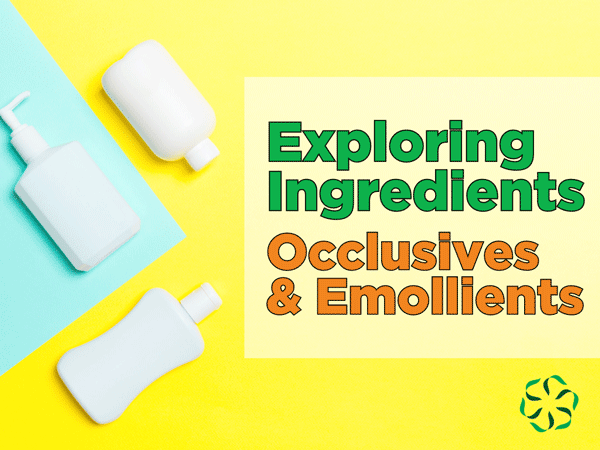In our last post, we broke down lotion ingredients. In this post, we look at two types of cosmetic ingredients: occlusives and emollients.
What are occlusives?
Occlusive ingredients create a physical barrier on top of the skin to keep skin moist and hydrated. These ingredients tend to be heavy, greasy, and often sticky.
Mineral oil, silicones, vegetable oils, animal fats, wax esters, hydrocarbons, and sterols are examples of occlusive ingredients (1,2).
Petroleum jelly (a hydrocarbon) is one of the best examples of an occlusive ingredient as it creates a barrier between our skin and the outside environment, keeping our skin moist.
What are emollients?
Emollient ingredients soften and smooth skin by exerting many effects on our skin like filling the spaces between our skin cells, improving skin barrier function, and enhancing membrane fluidity (1). Emollient ingredients tend to be softer, silky, and less bulkily on the skin than occlusive ingredients.
We can find emollient ingredients naturally in wool fat, palm oil, coconut oil, and more (1).
Oat ingredients, like Avena sativa (oat) kernel flour found in many oatmeal lotions, are emollient ingredients. Oat ingredients often contain lipids and other ingredients that help improve skin texture and suppleness.
What is the difference between an occlusive and an emollient ingredient?
Occlusive ingredients sit on the skin as a barrier rather than emollient ingredients that can influence how the skin cells function (1). However, many ingredients are both occlusive and emollient ingredients.
Lanolin oil is an excellent example of an ingredient that ticks both the occlusive and emollient boxes. As a result, you’ll find this ingredient in many lotions and cosmetic products
What do they do?
These ingredients are critical to providing the properties we value most in lotions. While not all creams contain powerful occlusive ingredients, most lotions will contain an emollient ingredient that works in conjunction with other ingredients like humectants to keep our skin soft and supple.
Are they regulated?
The U.S. Food and Drug Administration (FDA) regulates occlusive and emollient ingredients under cosmetic rules as they are commonly found in personal care products like lotions, moisturizers, hair care products, etc. (1,2).
However, the FDA does not approve nor test cosmetic products, including lotions, before they are on the market. Manufacturers are legally responsible for ensuring product safety when the products are used as intended. If there is a safety issue, the FDA can and will test products and issue recalls when necessary (1).
Products containing occlusive or emollient ingredients marketed for healing or improving a medical condition (e.g., eczema) are considered over-the-counter drugs, meaning they’re governed by the same FDA rules and regulations applicable to any over-the-counter pharmaceutical medications (1,2).
Are they safe to use?
Occlusive and emollient ingredients are safe when used as intended. Manufacturers are encouraged to test lotions and cosmetic products containing occlusive and emollient ingredients before they are available on the market.
However, some ingredients like lanolin can irritate skin or cause reactions in people with sensitive skin or allergies. If you have an allergy, it’s essential to avoid topical products containing those ingredients. Even mild adverse reactions can become more significant upon continued exposure.
Where can I learn more about individual ingredients?
You can learn general cosmetic safety information at https://cosmeticsinfo.org.
You can view in-depth cosmetic ingredient safety information and reports at https://www.cir-safety.org/ingredients.
The good news.
As we’ve all increased our hand washing and hand sanitizing practices throughout the past year, our hands are more likely to become dry and even cracked.
Using lotions that contain occlusive and emollient ingredients can help heal and protect our skin as we continue to follow best hygiene practices.

